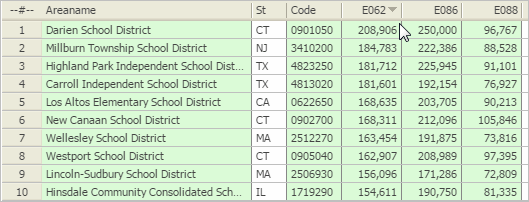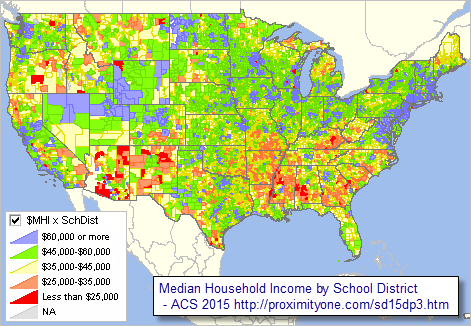

|
|
School District Demographic Economic Characteristics -- ACS 2015 Employment, Industry, Occupation Income, Insurance, Poverty, more
Median household income is one measure of economic prosperity. How do school districts of interest compare to peers or in a region? There are other measures that need to be considered for a more comprehensive look at the economic situation. This section is focused on tools, resources and methods that you can use to access, integrate and analyze school district economic characteristics. These data uniquely provide insights into many of the most important economic characteristics. This section updates in 2018. One of Four Sections. Approximately 600 subject matter items from the American Community Survey ACS 2015 database are included in these four pages/tables: • General Demographics • Social Characteristics • Economic Characteristics -- this page/section -- view table • Housing Characteristics School Districts with Highest Median Household Income Use the interactive table below in this section to examine economic characteristics of school districts. Below is a list of the 10 school districts having the highest median household income developed using the interactive tables.  - ranked on item E062 -- median household income. Patterns of Economic Prosperity by School District - median household income (item E062 in table)  - view developed with CVGIS software using related GIS project and datasets. Related Sections See related tables for Census Tracts | ZIP Codes | State, Metro & County. Using the Interactive Table Use the interactive table below to view, query, rank, compare economic characteristics for these areas. The scroll box shown below lists each of the subject matter items available for each area via the ranking table. In the subject matter items scrollbox, subject matter items are organized into to mini-tables with related items. The number at the left of the subject matter item is also used as the short name for the subject matter item in the column header in the ranking table. Affiliate Geography. This page introduces use of the Affiliate Geography. The rightmost column (Geo2) may contain a school district code for an affiliated school district. In this table, the affiliated code is only active for Phoenix Union High School District, AZ and affiliated, intersecting in this case, 13 elementary school districts. Click ShowAll button and then the Affiliate button below the table. The table refreshes showing only these districts. Now this set of districts may be sorted and viewed as a group. Affiliated geography coding is useful to examine related elementary/secondary districts (that overlap the same geography). Economic Characteristics Items .. a few item names and numbers changed from previous year data/table.
EMPLOYMENT STATUS
E001 Population 16 years and over E002 In labor force E003 Civilian labor force E004 Employed E005 Unemployed E006 Armed Forces E007 Not in labor force E008 Civilian labor force E009 Unemployment Rate E010 Females 16 years and over E011 In labor force E012 Civilian labor force E013 Employed E014 Own children of the householder under 6 years E015 All parents in family in labor force E016 Own children of the householder 6 to 17 years E017 All parents in family in labor force COMMUTING TO WORK E018 Workers 16 years and over E019 Car, truck, or van -- drove alone E020 Car, truck, or van -- carpooled E021 Public transportation (excluding taxicab) E022 Walked E023 Other means E024 Worked at home E025 Mean travel time to work (minutes) OCCUPATION E026 Civilian employed population 16 years and over E027 Management, business, science, and arts occupations E028 Service occupations E029 Sales and office occupations E030 Natural resources, construction, and maintenance occupations E031 Production, transportation, and material moving occupations INDUSTRY E032 Civilian employed population 16 years and over E033 Agriculture, forestry, fishing and hunting, and mining E034 Construction E035 Manufacturing E036 Wholesale trade E037 Retail trade E038 Transportation and warehousing, and utilities E039 Information E040 Finance and insurance, and real estate and rental and leasing E041 Professional, scientific, and management, and administrative and waste management services E042 Educational services, and health care and social assistance E043 Arts, entertainment, and recreation, and accommodation and food services E044 Other services, except public administration E045 Public administration CLASS OF WORKER E046 Civilian employed population 16 years and over E047 Private wage and salary workers E048 Government workers E049 Self-employed in own not incorporated business workers E050 Unpaid family workers INCOME AND BENEFITS (IN 2015 INFLATION-ADJUSTED DOLLARS) E051 Total households E052 Less than $10,000 E053 $10,000 to $14,999 E054 $15,000 to $24,999 E055 $25,000 to $34,999 E056 $35,000 to $49,999 E057 $50,000 to $74,999 E058 $75,000 to $99,999 E059 $100,000 to $149,999 E060 $150,000 to $199,999 E061 $200,000 or more E062 Median household income (dollars) E063 Mean household income (dollars) E064 With earnings E065 Mean earnings (dollars) E066 With Social Security E067 Mean Social Security income (dollars) E068 With retirement income E069 Mean retirement income (dollars) E070 With Supplemental Security Income E071 Mean Supplemental Security Income (dollars) E072 With cash public assistance income E073 Mean cash public assistance income (dollars) E074 With Food Stamp/SNAP benefits in the past 12 months E075 Families E076 Less than $10,000 E077 $10,000 to $14,999 E078 $15,000 to $24,999 E079 $25,000 to $34,999 E080 $35,000 to $49,999 E081 $50,000 to $74,999 E082 $75,000 to $99,999 E083 $100,000 to $149,999 E084 $150,000 to $199,999 E085 $200,000 or more E086 Median family income (dollars) E087 Mean family income (dollars) E088 Per capita income (dollars) E089 Nonfamily households E090 Median nonfamily income (dollars) E091 Mean nonfamily income (dollars) E092 Median earnings for workers (dollars) E093 Median earnings for male full-time, year-round workers (dollars) E094 Median earnings for female full-time, year-round workers (dollars) HEALTH INSURANCE COVERAGE E095 .. Civilian Noninstitutionalized Population E096 .... With health insurance coverage E097 ...... With private health insurance coverage E098 ...... With public health coverage E099 .... No health insurance coverage E100 .... Civilian Noninstitutionalized Population Under 18 years E101 ...... No health insurance coverage E102 .... Civilian noninstitutionalized population 18 to 64 years E103 ...... In labor force: E104 ........ Employed: E105 .......... With health insurance coverage E106 ............ With private health insurance E107 ............ With public coverage E108 .......... No health insurance coverage E109 ........ Unemployed: E110 .......... With health insurance coverage E111 ............ With private health insurance E112 ............ With public coverage E113 .......... No health insurance coverage E114 ...... Not in labor force: E115 ........ With health insurance coverage E116 .......... With private health insurance E117 .......... With public coverage E118 ........ No health insurance coverage PERCENTAGE OF FAMILIES AND PEOPLE WHOSE INCOME IN THE PAST 12 MONTHS IS BELOW THE POVERTY LEVEL E119 All families E120 With related children of the householder under 18 years E121 With related children of the householder under 5 years only E122 Married couple families E123 With related children of the householder under 18 years E124 With related children of the householder under 5 years only E125 Families with female householder, no husband present E126 With related children of the householder under 18 years E127 With related children of the householder under 5 years only E128 All people E129 Under 18 years E130 Related children of the householder under 18 years E131 Related children of the householder under 5 years E132 Related children of the householder 5 to 17 years E133 18 years and over E134 18 to 64 years E135 65 years and over E136 People in families E137 Unrelated individuals 15 years and over School District Economic Characteristics -- interactive table ACS 2015 5-year estimates Click ShowAll button between Find/Queries. Use mouseover on column header to view column description. See usage notes below table. See related tables -- http://proximityone.com/rankingtables.htm. Usage Notes • If table not showing any rows; click ShowAll button below table. • Use vertical and horizontal scroll bars to navigate up/down or left/right. • Adjust column widths using column divider between header cells. • CBSA> button -- use to select districts in a specified metro/CBSA .. get metro 5-character code here .. paste the 5-character metro code in the edit box to right of CBSA> button. .. overwriting the value 19100. .. click the CBSA> button ... table refreshes with all districts in specified metro. • Find Name> button -- use to select district based on exact spelling of partial name in column 1. .. Key in exact up/low case spelling of partial name of district in the edit box to right of Find Name> button. .. overwriting the value Dallas. .. click the Find Name> button ... table refreshes with all districts with matched spelling in column 1. • Selected columns -- click the "$MHI.$MFI.$PCI" below the table to show only these columns; .. click "All columns" button to restore view to all columns. • All items are estimates for 2015. • Click ShowAll button between specific area queries. • Cells with negative value could not be estimated (for this geography and this time frame). Selecting Districts within a Metro/CBSA --> Proceed with these steps to view districts within a selected metro/CBSA: • Click ShowAll button below table. • Click $MHI.$MFI .. button below table. • Click the CBSA> button (using the default Dallas metro CBSA code 19100). • Click the E062 column header; click again to sort in other direction. Examine a metro of interest -- get metro 5-character code here .. • Click ShowAll button below table. • Click $MHI.$MFI .. button below table. • Paste the 5-character metro code in the edit box to right of CBSA> button. .. overwriting the value 19100. • Click the CBSA> button. • Click the E062 column header; click again to sort in other direction. Use find codes/names to determine census tract, city/place, school district etc. geocode/area name based on address. Importance of Demographic-Economic Data The importance of understanding the demographic-economic make-up and trends can hardly be overstated. Community and educational challenges and opportunities are shaped by demographic-economic dynamics. Only by knowing "where we are" can we develop the most effective plans for improvement. The American Community Survey provides "richer" demographic-economic characteristics for national scope wide-ranging geographic areas. While Census 2010 provides data similar to those items in the General Demographics section, only ACS sourced data provide details on topics such as income and poverty, labor force and employment, housing value and costs, educational participation and attainment, language spoken at home, among many related items. The approximate 600 items accessible via the dataset are supplemented by a wide range of additional subject matter. These data are updated annually in December of each year for each/all political/statistical areas, including school districts, census tracts, ZIP code areas and block groups. ProximityOne User Group Join the ProximityOne User Group to keep up-to-date with new developments relating to metros and component geography decision-making information resources. Receive updates and access to tools and resources available only to members. Use this form to join the User Group. Support Using these Resources Learn more about accessing and using demographic-economic data and related analytical tools. Join us in a Data Analytics Lab session. There is no fee for these one-hour Web sessions. Each informal session is focused on a specific topic. The open structure also provides for Q&A and discussion of application issues of interest to participants. Additional Information ProximityOne develops geodemographic-economic data and analytical tools and helps organizations knit together and use diverse data in a decision-making and analytical framework. We develop custom demographic/economic estimates and projections, develop geographic and geocoded address files, and assist with impact and geospatial analyses. Wide-ranging organizations use our tools (software, data, methodologies) to analyze their own data integrated with other data. Follow ProximityOne on Twitter at www.twitter.com/proximityone. Contact us (888-364-7656) with questions about data covered in this section or to discuss custom estimates, projections or analyses for your areas of interest. |
|
|